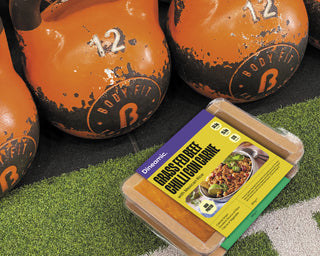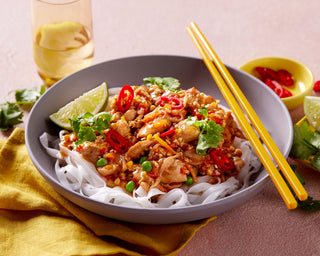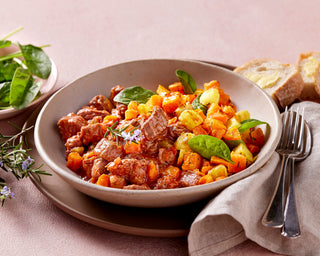
Ever been overwhelmed by flashy food packaging that screams PICK ME, I’m 100% natural, 99% fat-free, baked not fried, gluten free, dairy free, vegan and preservative free? Yep, us too. In reality, all you want is real food that is good and good for you without the need to google half the things you’re reading.
Don’t stress, we’re here to help by sharing some of the info, tips and industry tricks that we’ve learned over the years, so you’ll be able to understand what you’re looking at and how to make the right choices without even thinking.
It’s called food literacy, and it empowers you to navigate the food system (packaging, manufacturing, nutrition), make informed choices and understand exactly where and how your food has been produced. Studies have even shown that higher food literacy helps lead to positive nutrition behaviours ultimately reducing the onset of chronic diseases (1,2).
So let’s dive into food labelling, what must be included, can be included and what it all means.
- Product Name - Seen on the front of the packaging
-
Nutritional Panel
This will always be shown in the standard format and have the average amount of nutrients per serve and per 100g/ml of the product. Nutrients included are energy (kilojoules or calories), protein, fat, saturated fat, carbohydrate, sugar and sodium (salt).
The best way to compare similar products is using the per 100g column.
-
Ingredients
These are listed from largest to smallest (by weight added) and must include any substance (including food additives) that are used in the preparation or handling of the food.
For ingredients listed in the product name (known as 'characterising ingredients'), that ingredient’s % of the total ingredients must be included.
-
Allergens and advisory statements
Peanuts, tree nuts, milk, eggs, sesame seeds, fish, shellfish, soy and wheat need to be declared as an allergen as these food and food ingredients can cause severe allergic reactions.
Cereal containing gluten (e.g. wheat, rye, barley, oats, spelt and mixed bred strains (e.g. triticale) must also be declared to assist people with Coeliac disease and cereal allergies and Sulphite too if content exceeds 10 mg/kg.
Advisory statements such as 'may contain' are voluntary and acts as a guide by the food industry to allow for the management of potential cross contamination.
You'll soon see Lupin being added to the list of allergens as well with manufacturers given a deadline until the end of May 2018 to declare it.
-
Use-by & Best Before Dates - the location of this will depend on the product.
Any packaged foods that have a shelf life of 2 years or less must have either a ‘use-by’ or 'best-before' date.- 'Use-by' – the product must be eaten it before this date, it is more than likely unsafe to eat after the use-by date.
- ‘Best-before’ – the product is going to be best to eat before this date, but you can still eat it safely after this.
-
Weight - this will be on the front of the packaging & in the nutritional panel.
Suppliers must label food with accurate weights and measurements as regulated by the National Measurement Institute. So yes, that bag of chips supposedly does weigh what it says it does – the air is for padding (because no one like crushed chips).
When buying canned products, remember that weight shown includes all components that means any liquid added so check the % of the main ingredient if you wanted to find out exactly how much is ingredient vs liquid.
-
Directions for storage and Preparation
Instructions for storage and use are required for food that needs to be stored and prepared in a particular manner for health or safety reasons. Following these will mean that the food lasts to its use-by date.
-
Country of origin
This tells you where the product is produced, grown, made or packed. From the 1st of July 2018, a standard mark will be mandatory on most food products – this will bear a kangaroo, bar chart and explanatory text or a bar chart and explanatory text only.- Grown in Australia – 100% Aussie ingredients.
- Product of Australia – All ingredients are Australian and all major processing is undertaken here.
- Made in Australia from at least X% Australian ingredients – ingredients are from Australia or overseas and all major processing are manufactured here.
- Packed in Australia – Used for foods that contain ingredients from multiple countries and not from a single country.
- Product of xx – imported food made, grown or packed outside of Australia showing the country of origin on the label.
-
Details of the manufacturer
The name and address of the supplier, whether it’s the packer, manufacturer, vendor or importer.
-
Lot Identification or batch number - Often found with the use-by or best before date.
A lot identification will detail the batch in which the food was made. This won’t have an impact on you as a general rule, but it is vital if there are any issues with the product or in the situation of a food recall.

Nutrition & Health Claims
Broken down into three tiers with strict benchmarks, these are claims that may help make sense of the numbers in the nutritional panel
- Nutrition content claim – the statement that says a certain nutrient or substance is or is not contained in the food, for example, low fat or gluten free.
- General level health claim – this identifies something in the food that can affect your health (but not serious diseases), for example, calcium for healthy bones
- High level health claim – refers to a certain nutrient that can affect a serious disease or indicator of disease within the claimed by FSANZ. For example, lower salt intake may reduce blood pressure.
Tricky Terms
'Gluten free water' & ‘cholesterol-free rice’ are just two of the claims that exist in the world of food labelling. These claims exploit a gap in your food knowledge but it may mean you’re paying a premium because of a claim that is pretty much redundant. I mean come on, gluten free water?!
Here are some of the terminology tricks that are commonly seen in food and what they actually mean.
-
Natural
According to Mintel's Global New Products Database, the use of 'natural' has on new food and drink products globally from September 2016 to August 2017 (3). There is no regulation to the use of the claim 'natural' therefore it is open for interpretation. The ACCC only asks that the claim be in the best interest of the consumer as a guidance but natural may be viewed differently from manufacturers to food technologists to the everyday person. -
Serving size
The serving size is the manufacturer’s suggestion or how much you SHOULD eat in a serve. It does not reflect real life, I mean who stops at one Tim Tam? -
Healthy brand names
Research (4) has found that our perception of how healthy a food is can be swayed by the descriptor or brand name. Something important to keep in mind given that a recent study by CHOICE (5) found that almost half of the 200 products analysed with a 'healthy' brand name were high in either saturated fat, sugars or sodium. -
Multigrain vs wholegrain
Multigrain means ‘many types of grains’, have a look at the list of grains to make sure you are having wholegrains. It may be made from white flour with some added grains as opposed to full of wholegrain goodness. -
Vegan
It doesn’t always mean healthy! Vegan just means that there are no animal by-products, the food can (and often does) contain loads of artificial ingredients. So don’t go eat a packet of chocolate biscuits thinking they’re vegan & therefore healthy! -
No artificial flavours, colours or additives
Additives from a 'natural' or 'nature-identical' source can still be included. MSG is also technically a flavour enhancer and not a 'flavour'. -
No added sugar
Products that say this could still contain artificial sweeteners. It’s also good to keep in mind that products that don’t have added sugar can still be high in it because of naturally occurring sugars in the ingredients. -
'Proudly Australian'
You could be forgiven for thinking that the product itself is Aussie, but terms like this can often refer to the company who is manufacturing or importing and not the origin of ingredients (thank goodness for that bar chart being added!)
There is no doubt clean labelling has become a major trend in the food industry, but just because an ingredient is unfamiliar doesn’t always mean it’s bad for you. Citric Acid is a great example, it doesn’t sound great, but it naturally occurs in things like tomatoes & citrus.
The Cheat Sheet
We can try to constantly scan for sciency or artificial looking ingredients but when you're scrambling through the supermarket, hair in an (unintentional) messy bun, feet dragging because you're tired and hungry, who has time to read everything? We sure don’t.
So here’s the cheat sheet – the quick ways to take some of the key info we’ve touched on and streamline it for those times when you’re on the go.
- Look past the front of packaging. It’s where the health claims and flashy design lives.
- The longer the list of ingredients, the higher the likelihood it’s highly processed. Put it back on the shelf.
- If sugars, salt or saturated/trans fats the first few ingredients it’s likely to be a discretionary item (meaning it is ok occasionally, but not every day). Be mindful of the varying names of sugar, salt and fat as well as euphemisms may be included as well.
- If you do have time to look at the numbers in the nutritional panel, here are some to stick by so you know you’re always choosing the best.
|
Looking at the numbers in the per 100g column |
Best Choice |
Ok Sometimes |
Best to Avoid |
|
Total Fat |
Less than 3g |
3-10g |
More than 10g |
|
Saturated Fat |
Less than 1.5g |
1.5-3g |
More than 3g |
|
Sugar |
Less than 5g |
5-15g |
More than 15g |
|
Sodium (salt) |
Less than 120mg |
120-400mg |
More than 400mg |
|
Energy |
This all depends on the product itself, there’s no magic number but if it’s in the 600kJ per serve upper limit take a quick look at the ingredients again, it’s more than likely to be a discretionary item. |
||
|
Fibre |
Choose high fibre. Look at the per serve column and go for more than 3g per serve. |
||
[source: Adapted from Livelighter, Traffic Lights Nutritional Information Panel card]
Our tip for when you reach peak label laziness, but still care? If you don’t need to google the ingredients, and the in the ‘healthy’ range above, you should be ok. OR ditch the label altogether, go for fresh vegetables, fruits and meat instead. No labels are needed because it’s a no-brainer it’s packed full of nutrients!
Head of Dineamic Nutrition, Karen Inge, agrees. “Don’t get too bogged down with trying to make sense of all the numbers just focus on the ingredients list and ensure that you selecting a product that is made up of nutritious foods that you want to eat. In the end, it’s all about taste. If it doesn’t t taste great then no matter how good it is for you it won’t be a ‘frequent flyer’ in your fridge or pantry."
Hopefully this helps you to navigate the info overload on food labels. There’s a lot a lot to it, but if you can learn the basics and build your knowledge from there, then before you know it you’ll be making great food decisions without even realising it.
Let us know in the comments what you find most challenging about labels and packaging on food, and what you’d like to see on the blog in future.
References
-
Bryd-Bredbenner, C. (2004) Food preparation knowledge and attitudes of young adults. Implications for nutrition practice. Topics in Clinical Nutrition, 19(2), 154-163.
-
Bisogni, C.A., Jastran, M., Shen, L., & Devine, C.M.(2005). A biographical study of food choice capacity. Standards, circumstances, and food management skills. Journal of Nutrition Education and Behaviour, 37(6), 284-291.
-
Varela, P., Ares, G., Gimenez, A., & Gambaro, A. (2010). Influence of brand information on consumers’ expectations and liking of powdered drinks in central location tests. Food Quality and Preference, 21, 873-880.









